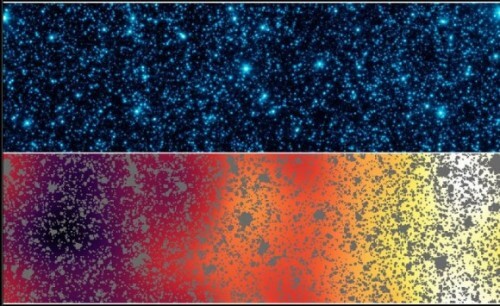The Spitzer Space Telescope looked back in time and saw what scientists call a pale clumpy glow emitted by the first objects in the universe. These objects propagated the oldest cosmic fireworks displays

The Spitzer Space Telescope looked back in time and saw what scientists call a pale clumpy glow emitted by the first objects in the universe. These objects propagated the oldest cosmic fireworks displays.
These fireworks were too blind and distant to detect the single object responsible for them, even though they were massive stars or even supermassive black holes. However, Spitzer captured the common pattern of infrared light, which revealed that there were countless such events, consuming the cosmic fuel.
"These objects were extremely bright" says Alexander Sasha Kashlinsky. The lead researcher in the article published in the Astrophysical Journal. "We cannot rule out mysterious sources for this light that could have come from the nearby universe, but it now becomes especially likely that what we are capturing is a glow from an ancient era. Spitzer is creating a road map for NASA's future James Webb telescope, which will tell us exactly what these objects are and where they have been."
This is not the first time astronomers have used Spitzer to search for the first stars and black holes. In 2005 they saw hints of a distant pattern of light known as the cosmic infrared background radiation. They did it again, this time with greater precision in 2007. Now Spitzer, who is in the extension phase of his mission, in which he performs more in-depth studies of specific areas of the sky. Kashinsky and his colleagues used Spitzer to observe these two patches of sky for over 400 hours each.
The team members excluded the known stars and galaxies located in these areas. Instead of being left with a black and empty stretch of space, they found pale patterns of light - the telltale muffins of the infrared universe in the distant background. The lumps observed in the pattern are consistent with the way in which
The clumps in the observed pattern are consistent with the way distant objects are supposed to be clumped together.
Kschilinski linked these observations to watching the spectacle of the 4th of July fireworks in New York from Los Angeles. First it is necessary to eliminate all the light that is in the middle between the cities, as well as the usual lights of New York itself. Finally you are left with a vague pattern that shows how the fireworks are scattered, but still any individual fireworks display will be undetectable due to distance.
"We can pick up clues from the first Asher shows in the universe," Kashlinsky said. This teaches us that these sources or flashes have consumed their nuclear fuel strongly."

7 תגובות
Thanks…
What a spitz.
Not an automatic translation but I used Word's translator specifically only for this word because I didn't know it.
It seems that this is an attempt at an automatic translation of the word: telltale (indicating gossip, revealing a secret), the meaning is that in addition to the pale (dim) patterns there were other characteristics that hinted at infrared background radiation. (By the way it's infrared because of the large deflection, Hubble's law).
What is "merchandise"?
In the sentence: "They found pale molds of pale light - the commercial bakeries..." ??
what a luck ! A microsecond later, the light from the beginning of the universe has already passed the earth.
Stunning